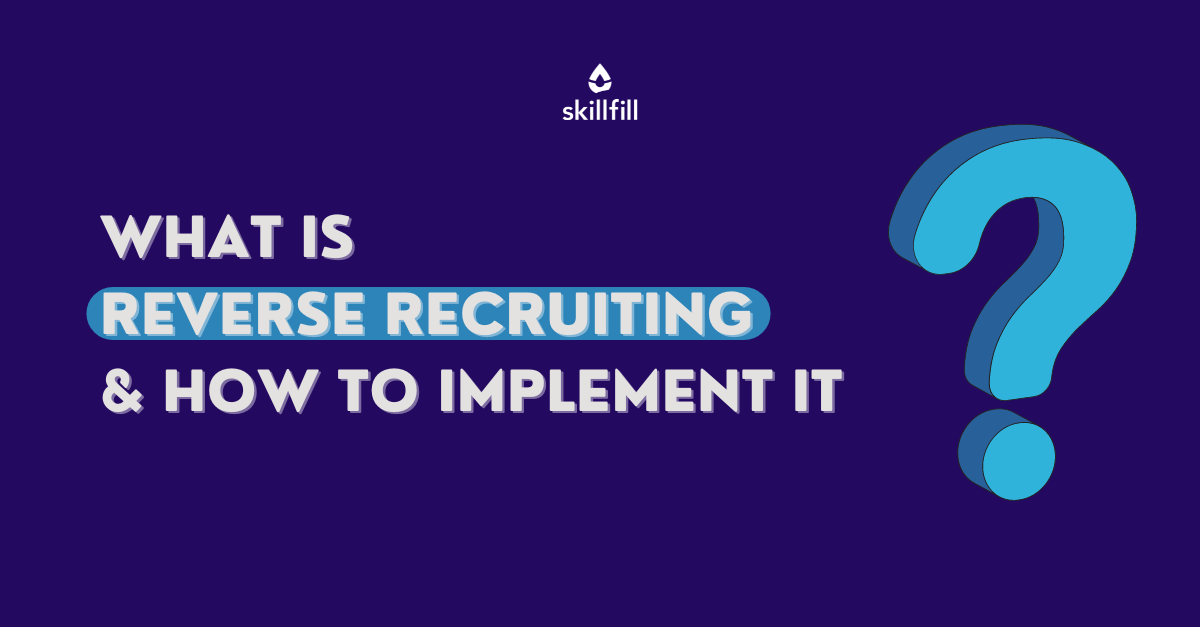Draw In Top Talent: Just How Reverse Recruiting Can Profit Your Business
Draw In Top Talent: Just How Reverse Recruiting Can Profit Your Business
Blog Article
Boost Your Hiring Game With Strategic Reverse Recruiting Approaches
In the world of skill purchase, standard recruiting methods have actually long been the norm. As the landscape of employing evolves, organizations are progressively turning to ingenious methods such as strategic reverse recruiting to get a competitive edge in protecting top skill. This change in way of thinking needs a thoughtful reconsideration of how companies come close to the employing procedure, focusing on bring in easy candidates as opposed to entirely counting on active work hunters. By flipping the script and proactively engaging with individuals who might not be proactively seeking new opportunities, companies open themselves as much as a pool of untapped potential. This calculated approach not only broadens the talent pipe yet also cultivates a much more diverse and experienced workforce.
Understanding Tactical Opposite Recruiting
Strategically leveraging the concept of reverse recruiting can dramatically improve your company's skill acquisition method. By flipping the standard recruitment method on its head, reverse recruiting includes proactively seeking and attracting easy candidates that may not be actively trying to find new possibilities. This aggressive technique allows firms to touch into a swimming pool of top notch talent that may not come through standard job posts alone.
Comprehending the intricacies of strategic reverse recruiting is vital for its successful application. It requires a deep understanding of the industry landscape, competitor analysis, and the certain ability collections that are in high need. reverse recruiting. By carrying out detailed study and leveraging market insights, organizations can recognize and engage with leading ability in an extra customized and targeted manner

Benefits of Reverse Recruiting
Reverse recruiting uses a distinct approach to skill procurement by proactively engaging with easy candidates who may not be proactively seeking work possibilities. This technique allows business to tap right into a pool of skill that standard recruiting approaches might overlook. One of the vital benefits of reverse recruiting is the capability to target candidates that are already utilized and satisfied in their existing functions. These individuals are usually leading entertainers in their corresponding areas, bringing valuable skills and experience to the table.

Key Parts of Reverse Recruiting
Having actually explored the advantages of reverse recruiting in targeting leading performers who are material in their present functions, it is vital to recognize the key components that make this method successful in bring in easy prospects. Passive prospects are commonly not actively looking for brand-new possibilities, so having a favorable reputation as an employer can pique their passion.
An additional essential element is individualized outreach. Considering that easy prospects are not actively seeking tasks, generic recruitment messages are most likely to be ignored. Customizing outreach initiatives to highlight how the details abilities and experiences of the candidate straighten with the business's needs can significantly increase the opportunities of getting their interest.
Furthermore, fostering connections with passive candidates in time is crucial. Frequently involving with them through networking events, sector conferences, and even periodic check-ins can help develop relationship and trust, making them a lot more receptive to potential task chances in the future. By including these key components right into reverse recruiting approaches, organizations can efficiently bring in and hire top talent from the swimming pool of passive prospects.
Executing Reverse Recruiting Approaches

Additionally, creating engaging employer branding and showcasing a positive firm society can assist attract easy prospects and motivate them to consider brand-new career possibilities. Building a skill area or skill pipe can additionally be useful in supporting partnerships with passive candidates over time, maintaining them involved and interested in potential future roles within the organization. On the whole, executing reverse recruiting methods calls for an aggressive and individualized technique to talent acquisition, concentrating on developing purposeful links with easy prospects to drive long-term recruitment success.
Determining Success backwards Hiring
Efficient measurement of success in recruiting methods needs a thorough evaluation of key efficiency indications and metrics to evaluate the impact and effectiveness of talent purchase initiatives. In the context of reverse recruiting, particular metrics can give useful insights into the performance and performance of the strategy. One important metric is the top quality of prospects engaged with reverse recruiting networks. By gauging the conversion rate of passive prospects right into energetic candidates or works with, organizations can gauge the performance of their reverse recruiting campaigns.
In addition, tracking the time-to-fill metric for settings about his loaded via reverse recruiting can provide useful information on the efficiency of the procedure. A shorter time-to-fill shows that the method is drawing in qualified prospects immediately. Keeping track of retention rates among prospects hired with reverse methods can provide insights right into the long-term success of the technique. High retention prices recommend that the prospects sourced via reverse recruiting are a good fit for the company, adding favorably to its overall ability pool. By examining these crucial look at more info metrics, services can efficiently gauge the success of their reverse recruiting initiatives and make notified decisions to maximize their skill procurement strategies.
Final Thought
To conclude, strategic reverse recruiting provides a distinct approach to working with that concentrates on drawing in leading talent via proactive involvement and relationship-building. By leveraging this approach, organizations can acquire an one-upmanship in the ability market and boost their recruitment results. It is vital to understand the benefits, crucial components, and techniques of reverse recruiting to efficiently carry out and measure success in this cutting-edge approach to hiring.
Report this page